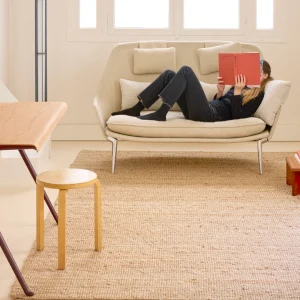
For Pete Collard, collating some of best design work produced in the past year for the Designs of the Year exhibition, on show at the Design Museum in London until 7 July, sounds like a dream job.
As curator, Collard was in charge of the team whose job it was to whittle down the long-list of work nominated by an extensive network of industry experts to 99 of the most exciting and innovative examples of furniture, architecture, product, graphics, digital, fashion and transport design.
But then Collard is a design expert who studied art history and Italian at the University of Sussex, and gained two MAs, in the history of design and material culture, at the University of Brighton. He then moved on to be curator of contemporary design at Kinston University, and has worked as a curator for the British Council and London Design Festival.
Yet he’s glad the near-impossible task of choosing an outright winner fell not to him but to a panel of judges, this year comprising designer and Studioilse founder Ilse Crawford, architect Amanda Levete, designer Olga Polizzi of Rocco Forte Hotels, designer Nicolas Roope, writer Sarah Raven, design journalist Johanna Agerman Ross, and comedian and television presenter Griff Rhys Jones.
‘It’s a very difficult thing to predict where the winner will come from,’ says Collard, when I spoke to him before the winner was announced, ‘and I’m delighted not to be part of that process!’ Indeed, the overall winner – the redesigned UK government website gov.uk – has been a controversial choice. The Daily Mail’s website, Mail Online, which itself won a Design Effectiveness Award this year, branded it ‘boring and basic-looking’.
But Collard says basic-looking is exactly what it’s supposed to be: ‘The website, by design, is simple and uncluttered – a design that doesn’t include the unneeded. It has been referred to as “boring” but that is actually the point: it’s basic and easy to use and hits the true purpose of the site.’
Collard suggests that criticism of the winner may actually be ‘a reflection on the popularity of the current Government rather than the website itself,’. In the case of the Daily Mail it could also have something to do with the fact that the website was designed by the Government’s own in-house team, Government Digital Service, rather than a designer from the private sector. Launched in October last year with the motto ‘simpler, clearer, faster’, gov.uk brings all of the Government’s websites together under one domain. The design team took inspiration from historic public service design, particularly the UK motorway signage developed by Margaret Calvert and Jock Kinneir in the Sixties.
But does the site, which Design Museum director, Deyan Sudjic has called ‘simple, direct [and] well mannered’, live up to the Designs of the Year mission statement, namely to ‘showcase the most innovative and imaginative designs from around the world’, better than, say, Thomas Heatherwick’s Olympic Cauldron or Renzo Piano’s The Shard, both of which were nominated?
‘I think the judges responded to the impact that the website will have on people’s lives,’ says Collard. ‘From the shortlist this is the one design that will have the most direct interaction and engagement with the public. This understated piece of work demonstrates what design is all about: improving our everyday lives.’
Since it first took place in 2008 as the Brit Insurance Design Award, Designs of the Year has grown into one the most hotly anticipated events in the UK design calendar and styles itself as the ‘Oscars of the design world,’ though it probably has more in common with art’s Turner Prize.
But as well as being a competition, Designs of the Year is also an exhibition that celebrates great design and brings conceptual and often controversial work to an audience that might not otherwise get to appreciate it, says Collard.
‘The aim of the exhibition is to demonstrate the scope of design, how design is represented in the world and the fact that design is all around us,’ he says. ‘I think that’s why the exhibition is very successful and always appeals to the public, because people see projects that range from quite commercial to smaller-scale socially aware projects, working with emerging or developing communities, developing economies. It’s really demonstrating what design is.’
If Designs of the Year has come in for criticism, it tends to be because of the way it pits such different design disciplines against each other. Writing in The Telegraph, architecture critic Jonathan Glancey wished the judges luck, asking, ‘How can they weigh Renzo Piano’s Shard in the balance with Orhan Pamuk’s Museum of Innocence in Istanbul, or Heatherwick’s Olympic Cauldron with a pair of brightly coloured spectacles by Joshua Silver, a retired Oxford University physics professor, for the Centre for Vision in the Developing World?’
But Collard says this is actually one of Designs of the Year’s greatest strengths: ‘Design means all of these things; it’s such a fluid term. It’s always a challenge for us to demonstrate or explore that idea. Designs of the Year is the one exhibition where we’re really able to express every different facet of what design is and show it in a very contemporary way.’
Another is that it brings together household names such as Zaha Hadid, whose Galaxy Soho building in Beijing was nominated this year, with lesser-known designers and design practices such as London-based Vitamins, whose folding wheel won this year’s transport category. Indeed past overall winners, including a folding plug by RCA graduate MIn-Kyu Choi and a designer energy-saving light bulb by Samuel Wilkinson, prove that this really is anyone’s competition.
‘I think it’s important to remember that it’s Designs of the Year, not designer of the year,’ says Collard. ‘It’s about the concept and showing good design thinking – that’s really what the judges look for and that’s what we look for too.’
This article was first published in fx Magazine.





